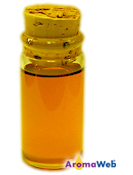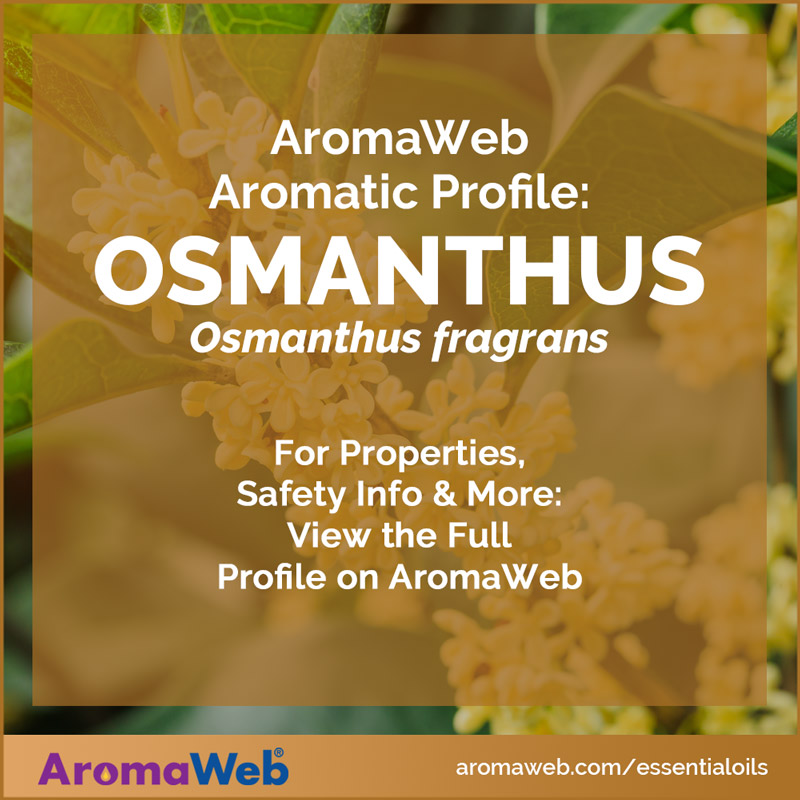Osmanthus Absolute
Osmanthus fragrans

Description
Although Osmanthus Absolute is not widely used for aromatherapy applications due to its significant cost and limited research, it is a precious and rather rare aromatic that holds great intrigue and adoration to aromatherapists. Osmanthus Absolute plays an important role in natural fragrancing and commercial perfumery applications.
The species Osmanthus fragrance belongs to the Oleaceae plant family. Jasmine and Lilac are examples of other exquisitely aromatic flowering botanicals that also belong to the Oleaceae plant family.
Osmanthus is also sometimes known as Sweet Olive and Sweet Osmanthus. Native to Asia, particularly China, Osmanthus is a small evergreen tree or shrub that produces beautiful aromatic flower clusters that are frequently yellow or orange in color. There are several sub species of Osmanthus fragrance and I'm not clear which are used for the Osmanthus Absolute that is currently available from reputable sellers.
The etymology of osmanthus originates from two Greek words, osma referring to aroma or fragrance, and anthos that means flower.
I am exquisitely delighted by the aroma of Osmanthus Absolute. Osmanthus Absolute is commonly referred to as smelling like apricots or peaches, leather and sometimes as having musky or animalistic characteristics. My most prized vial of Osmanthus Absolute smells strongly of apricot or peach with complementary delicate notes of leather, tobacco, cream and vanilla.
The aroma of Osmanthus Absolute is very tenacious, and it lasts several days on a fragrance test strip.
Tony Burfield describes the aroma of Osmanthus Absolute as having "an intense apricot odour, also leathery, with a slight berry note. Mellow. Fig-like presence develops after a few minutes. Dry-down: similar to top note: powerful apricot, leathery, with slight hay note, but more creamy, fatty penetratingly cold, and with alcoholic beverage note, like whisky." [Source: Tony Burfield, Natural Aromatic Materials: Odours & Origins, Second Edition (Tampa, FL: The Atlantic Institute of Aromatherapy, 2016), 579.]
Of no surprise, Tony Burfield mentions that Osmanthus Absolute is used in high-end perfumes and fragrances.
Within Perfume and Flavor Materials of Natural Origin, Steffen Arctander explains that "the yield of absolute from concrete [of Osmanthus Absolute] is only about one kilo per 3,000 kilos of flowers..." That is a mere fraction of a percent and helps to explain why Osmanthus Absolute costs so much.
Due to its cost, I save my Osmanthus Absolute for my most precious aromatherapy and fragrancing formulations. I love using it to scent body butters, body oils, serums and lotions. I have also been known to use it in minute quantities to add a very exquisite touch to aromatherapy blends intended to help soothe anxiety and the nerves.
A little certainly goes a long way. Incorporating even a tiny amount of Osmanthus Absolute can transform an otherwise bland blend into a much more aromatically beautiful blend.
Osmanthus Absolute blends well with so many essential oils and aromatics, but the following essential oils and absolutes come to mind as blending especially well with Osmanthus Absolute: Sandalwood, Vanilla, Jasmine, Neroli, Atlas Cedarwood, Magnolia, Muhuhu, Amyris, Ylang Ylang, Mandarin and Yuzu.
A review of several GC/MS reports indicates that Osmanthus Absolute can contain fatty acids including linolenic acid, linoleic acid and palmitic acid at percentages higher than what we see in some other floral absolutes like Jasmine Sambac, Jasmine Grandiflorum and Rose.
Osmanthus Absolute Benefits and Uses
Osmanthus Absolute is primarily used in perfumery and fragrancing.
Julia Lawless suggests that it may be beneficial for the following uses:
- Mature Skin
- General Skin Care
- Anxiety
- Depression
- Tension
- Mood Swings
- Stress
Source: Julia Lawless, The Encyclopedia of Essential Oils Updated Edition (London: Harper Thorsons, 2014), 158.
Botanical Name
Plant Family
Common Method of Extraction
Solvent Extraction
Learn what the terms absolute and solvent extraction mean.
Plant Part Typically Used

Color
Orange / Amber
Consistency
Medium to Slightly Thick
Perfumery Note
Base
Strength of Initial Aroma
Medium
Aromatic Description
Osmanthus Absolute is commonly referred to as smelling like apricots or peaches, leather and sometimes as having musky or animalistic characteristics. See the introductory information at the top of the page for more aromatic details.
Sustainability and Conservation Status
Least ConcernSource: https://www.iucnredlist.org/species/147642268/147642270
To learn more about the conservation status of essential oil bearing plants and how to use the IUCN Red List of Threatened Species, please refer to AromaWeb's Guide to Essential Oils and Sustainability.
Major Aromatic Constituents
- B-Ionone
- Dihydro-B-ionone
- Gamma-Decalactone
- Linalool
- Geraniol
- (E)-Linalool Oxide
- (Z)-Linalool Oxide
- Decan-4-olide
- Dihydro-B-ionol
- a-Ionone
- 2-Phenylethanol
Sources: B.M. Lawrence, Essential Oils 1981-1987 (Wheaton: Allured Publishing, 1989), 188-190. D.P. Anonis, Flower Oils and Floral Compounds in Perfumery, 1993 (Allured, Carol Stream) as cited in Essential Oil Safety (Second Edition. United Kingdom: Churchill Livingstone Elsevier, 2014), 378.
Osmanthus Absolute Safety Information
Tisserand and Young do not indicate any special precautions when using Osmanthus Absolute. Reading Tisserand and Young's full profile is recommended. Source: Robert Tisserand and Rodney Young, Essential Oil Safety (Second Edition. United Kingdom: Churchill Livingstone Elsevier, 2014), 378.
Osmanthus Absolute References
- Julia Lawless, The Encyclopedia of Essential Oils Updated Edition (London: Harper Thorsons, 2014), 158.
- From East to West: The Universal Appeal of Osmanthus Flower Symbolism on Petal Republic Last Accessed On December 16, 2023
- Osmanthus on Wikipedia Last Accessed On December 16, 2023
- Tony Burfield, Natural Aromatic Materials: Odours & Origins, Second Edition (Tampa, FL: The Atlantic Institute of Aromatherapy, 2016), 579.
- Steffen Arctander, Perfume and Flavor Materials of Natural Origin (Reprint Edition. Elizabeth, NJ: Pathfinder., 2017), 499.
General Safety Information
Do not take any oils internally and do not apply undiluted essential oils, absolutes, CO2s or other concentrated essences onto the skin without advanced essential oil knowledge or consultation from a qualified aromatherapy practitioner. For general dilution information, read AromaWeb's Guide to Diluting Essential Oils. If you are pregnant, epileptic, have liver damage, have cancer, or have any other medical problem, use oils only under the proper guidance of a qualified aromatherapy practitioner. Use extreme caution when using oils with children and be sure to first read the recommended dilution ratios for children. Consult a qualified aromatherapy practitioner before using oils with children, the elderly, if you have medical issues or are taking medications. Before using this or any essential oil, carefully read AromaWeb's Essential Oil Safety Information page. For in-depth information on oil safety issues, read Essential Oil Safety by Robert Tisserand and Rodney Young.
Shelf Life
Important Information About the Profiles
The essential oil information provided on AromaWeb is intended for basic educational purposes only. The references to safety information, test results, constituents and percentages is generalized information. Essential oils can vary greatly in composition. The data is not necessary complete and is not guaranteed to be accurate. The essential oil photos are intended to represent the typical and approximate color of each essential oil. However, essential oil composition and color can vary based on harvesting, distillation, age of the essential oil and other factors. Profiles for several CO2 Extracts and absolutes are included within the directory, and are denoted as such.
